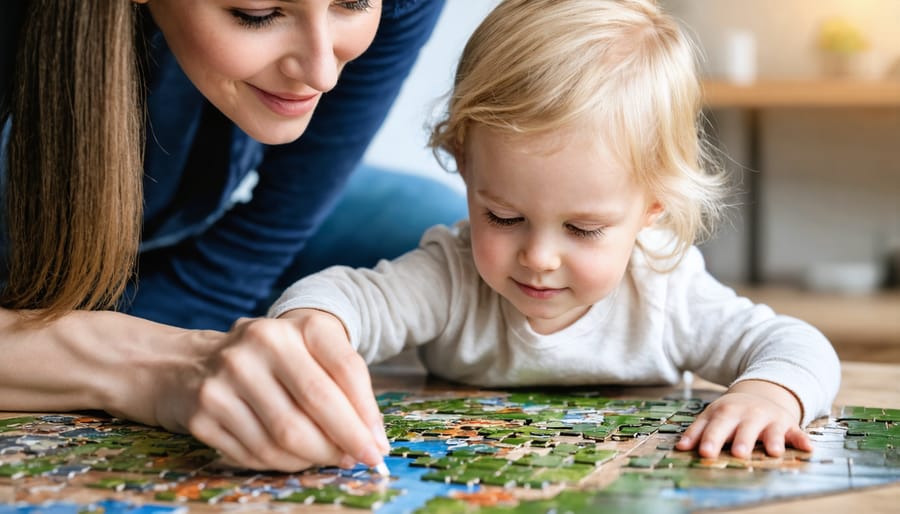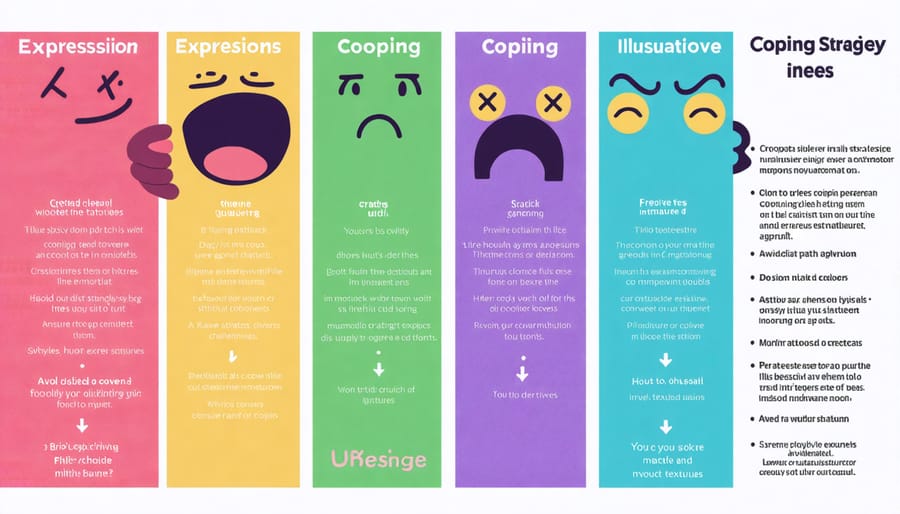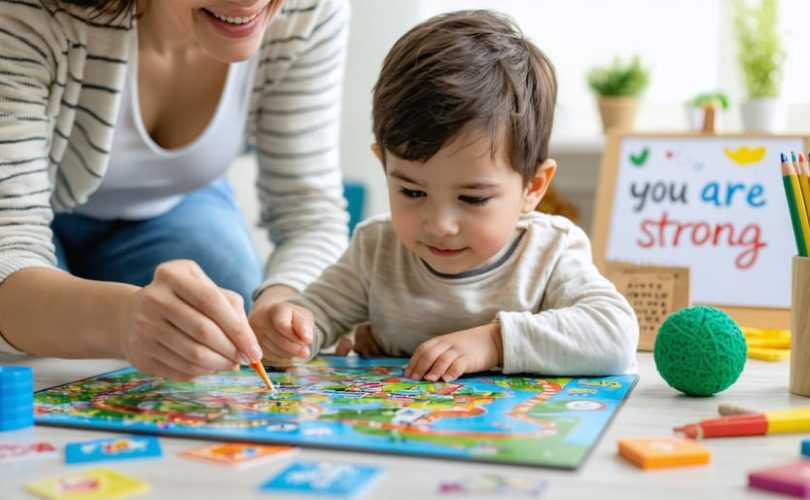Building mental health resilience starts by recognizing that emotional strength isn’t fixed – it’s a skill we can actively develop at any age. Just as we exercise our bodies, we can strengthen our psychological muscles through daily practices that enhance our ability to bounce back from life’s challenges. Learning to boost your child’s mental health and resilience creates a foundation for lifelong emotional wellbeing.
Research shows that resilient individuals share key characteristics: strong support networks, effective coping strategies, and the ability to frame challenges as opportunities for growth. These aren’t innate traits, but learned skills that parents, educators, and caregivers can nurture through consistent, compassionate guidance.
Think of mental health resilience as building an emotional immune system – one that doesn’t just help us survive difficult times, but enables us to thrive despite them. By understanding and practicing resilience-building techniques, we equip ourselves and our children with vital tools for navigating life’s inevitable ups and downs with confidence and grace.
Whether facing everyday stressors or significant life changes, developing mental health resilience empowers us to maintain balance, preserve hope, and emerge stronger from challenges. This journey begins with small, intentional steps that gradually build lasting emotional strength.
Understanding Mental Health Resilience

Key Components of Mental Resilience
Mental resilience is built on three fundamental pillars that work together to create emotional strength in children. The first is emotional awareness – the ability to recognize, understand, and express feelings in healthy ways. When children can name their emotions and understand why they feel certain ways, they’re better equipped to handle life’s challenges.
Adaptability forms the second key component, enabling children to adjust to new situations and bounce back from setbacks. As Dr. Sarah Chen, child psychologist, notes, “Children who can adapt to change show greater confidence when facing new challenges.” This flexibility helps them navigate everything from changing schools to dealing with disappointment.
The third essential element is developing effective coping mechanisms. These are the practical tools and strategies children use to manage stress and difficult emotions. Some children might find comfort in deep breathing exercises, while others might benefit from physical activity or creative expression through art. The key is helping each child discover what works best for them.
Together, these components create a foundation for lasting mental resilience, giving children the tools they need to face life’s ups and downs with confidence.
Why Resilience Matters in Childhood
Childhood resilience acts as a powerful shield against life’s challenges, setting the foundation for lifelong mental health and emotional well-being. Research shows that resilient children are better equipped to handle stress, overcome obstacles, and maintain positive relationships throughout their lives.
Dr. Sarah Chen, a child psychologist, explains, “When children develop resilience early on, they’re essentially building emotional muscles that will serve them well into adulthood. These skills become their go-to tools during difficult times.”
The benefits of childhood resilience extend far beyond emotional strength. Resilient children typically perform better academically, show greater creativity in problem-solving, and maintain healthier relationships with peers. They’re also less likely to develop anxiety and depression later in life.
Consider eight-year-old Maya’s story: After moving to a new school, she initially struggled with the change. However, her developed resilience skills helped her adapt, make new friends, and even excel in her new environment. Her mother shares, “The coping strategies we practiced together made all the difference in how she handled the transition.”
By fostering resilience early, we give children the emotional toolkit they need to navigate life’s inevitable challenges with confidence and grace.
Building Resilience Through Education
Age-Appropriate Learning Activities
Building mental health resilience looks different at various developmental stages. Here’s how you can engage children in age-appropriate activities that strengthen their emotional well-being:
For Preschoolers (Ages 3-5):
– Emotion face drawings: Let children draw different feelings and discuss them
– “Feelings jar” with colored water to represent emotions
– Mindful breathing using pinwheels or bubble-blowing
– Simple yoga poses with animal names
– Puppet play to act out challenging situations
For Elementary Age (Ages 6-11):
– Gratitude journaling with pictures and simple sentences
– “Worry box” crafting and decoration
– Stress ball making activity
– Group problem-solving games
– Body scanning relaxation exercises
– Friendship-building circle time activities
For Teenagers (Ages 12-18):
– Mood tracking through creative art or journaling
– Guided meditation sessions
– Physical activities like team sports or dance
– Peer support group discussions
– Goal-setting workshops
– Stress management through music or art therapy
Remember to adjust these activities based on individual maturity levels and interests. Start with shorter durations for younger children and gradually increase engagement time. Create a safe, judgment-free environment where children feel comfortable expressing themselves and asking questions. Celebrate small victories and progress rather than focusing solely on outcomes.
Creating Supportive Learning Environments
Creating a supportive learning environment is essential for building mental health resilience in children. When children feel safe and supported, they’re more likely to express their emotions, take healthy risks, and develop crucial coping skills.
Start by establishing clear routines and expectations while maintaining flexibility. For example, having a consistent daily schedule helps children feel secure, but being able to adjust when needed teaches adaptability. Create designated spaces where children can retreat when feeling overwhelmed – this might be a cozy reading corner or a calming sensory area with soft cushions and fidget toys.
Dr. Sarah Chen, a child psychologist, emphasizes the importance of positive reinforcement: “When we celebrate effort rather than just outcomes, we help children develop a growth mindset and emotional resilience.” Encourage open dialogue by modeling emotional expression and active listening. Simple phrases like “I notice you seem frustrated” or “Would you like to talk about it?” can open doors to meaningful conversations.
Physical environment matters too. Display inspiring messages, create artwork celebrating diversity, and ensure the space is accessible to all abilities. Remember to incorporate movement opportunities throughout the day, as physical activity naturally supports emotional regulation.
Most importantly, maintain a judgment-free atmosphere where mistakes are viewed as learning opportunities. This approach helps children feel confident in expressing themselves and seeking help when needed.

Incorporating Daily Resilience Practices
Building resilience isn’t about making dramatic changes; it’s about incorporating small, meaningful practices into your child’s daily routine to nurture mental well-being. Start each day with a positive morning ritual, such as sharing three things you’re grateful for during breakfast. This simple practice helps children develop an optimistic mindset and emotional awareness.
Encourage regular physical activity, whether it’s a family walk after dinner or dancing to favorite songs. Movement naturally releases stress and boosts mood-enhancing chemicals in the brain. Create a dedicated “calm corner” where children can go when feeling overwhelmed, equipped with comfort items like stress balls, coloring books, or peaceful music.
Practice deep breathing exercises together during transition times, like before homework or bedtime. The “balloon breath” technique – imagining filling and deflating a balloon in your belly – makes this exercise fun and memorable for children.
End each day with a reflection routine. Ask your child about their “rose” (something good), “thorn” (something challenging), and how they handled difficult moments. This helps process emotions and builds problem-solving skills. Remember to celebrate small victories and efforts, not just outcomes, reinforcing the message that growth comes through both successes and challenges.
The Role of Parents and Caregivers
Modeling Resilient Behavior
Children learn by observing, and as adults, we play a crucial role in empowering your child by demonstrating healthy ways to handle life’s challenges. When we model resilient behavior, we provide them with real-life examples they can emulate.
Start by expressing emotions openly and appropriately. Instead of hiding your frustrations, say something like, “I’m feeling stressed about this deadline, but I’m going to take deep breaths and break this big task into smaller steps.” This shows children that it’s normal to have difficult feelings and healthy ways to manage them.
Share your problem-solving process out loud. For example, if you make a mistake at work, verbalize your thoughts: “I made an error in this report. While I’m disappointed, I’m going to learn from this experience and double-check my work next time.” This demonstrates both accountability and growth mindset.
Practice self-care visibly. Let your children see you taking walks to clear your head, reaching out to friends for support, or engaging in calming activities like reading or gardening. Explain why these activities help you feel better: “When I feel overwhelmed, going for a walk helps me think more clearly.”
Remember to show self-compassion. Instead of harsh self-criticism, use kind self-talk: “I didn’t handle that situation perfectly, but I did my best, and I can try a different approach next time.” This teaches children that making mistakes is part of learning and growth.
When facing setbacks, demonstrate optimism balanced with realism. Share both your challenges and your strategies for overcoming them, showing that resilience is an ongoing journey rather than a fixed destination.

Communication Strategies
Open and honest communication is fundamental to building mental health resilience in children. Creating a safe space where children feel comfortable expressing their emotions starts with active listening and validation. When a child shares their feelings, respond with empathy and avoid dismissing their concerns, even if they seem trivial from an adult perspective.
One effective strategy is the “emotion coaching” approach. Start by acknowledging the emotion (“I can see you’re feeling frustrated”), validate their experience (“It’s normal to feel that way when things don’t go as planned”), and then help them problem-solve (“Would you like to talk about what might help?”).
Use age-appropriate language and concrete examples when discussing complex emotions. For younger children, you might compare feelings to weather patterns – like a stormy day for anger or a sunny day for happiness. Older children might benefit from using emotion rating scales or journaling to track and communicate their feelings.
Regular check-ins can help normalize conversations about mental health. Create dedicated times for open dialogue, such as during family meals or before bedtime. Remember to share appropriate examples from your own experiences, showing that everyone faces challenges and learns to cope with difficult emotions.
When children struggle to verbalize their feelings, offer alternative communication methods. Drawing, playing with toys, or using emotion cards can help them express themselves more comfortably. If a child seems reluctant to talk, respect their boundaries while letting them know you’re always available to listen when they’re ready.
Signs of Progress and When to Seek Help
Positive Indicators
When mental health resilience strategies are working effectively, you’ll notice several encouraging signs in children. They begin showing greater confidence in facing challenges and demonstrate improved problem-solving skills when dealing with obstacles. You might observe them bouncing back more quickly from disappointments or setbacks, rather than remaining upset for extended periods.
Children with growing resilience often express their feelings more openly and clearly. They’re more likely to ask for help when needed and show increased comfort in discussing both positive and difficult emotions. Their relationships with peers typically improve, and they demonstrate better cooperation and empathy.
Watch for enhanced self-regulation skills, such as calming themselves down when frustrated or waiting patiently for their turn. You may notice them using coping strategies they’ve learned, like deep breathing or positive self-talk, without prompting.
Another positive indicator is increased independence in daily activities and decision-making, coupled with a willingness to try new things. Children might also show greater optimism about future challenges and express pride in overcoming past difficulties.
These changes often develop gradually, so celebrate small improvements and continue supporting their journey toward emotional strength.
When Professional Support Is Needed
While building mental health resilience is essential, there are times when professional support becomes necessary. It’s important to recognize that seeking help is a sign of strength, not weakness. Watch for persistent changes in your child’s behavior, such as withdrawal from activities they once enjoyed, significant mood swings, or changes in sleeping or eating patterns that last more than two weeks.
If your child expresses thoughts of self-harm, experiences severe anxiety that interferes with daily activities, or shows signs of depression, don’t hesitate to reach out to mental health professionals. There are various treatment options available, from counseling to therapy programs specifically designed for children.
Remember that early intervention often leads to better outcomes. Your child’s pediatrician can be an excellent first point of contact, as they can provide initial guidance and refer you to appropriate specialists. School counselors and mental health helplines are also valuable resources for immediate support and direction.
Trust your parental instincts – if you feel something isn’t right, it’s better to seek professional advice and create a support network for your child’s mental well-being.
Building mental health resilience is an ongoing journey that requires patience, understanding, and consistent support. Remember that every child’s path to emotional strength is unique, and small steps forward deserve celebration. By implementing the strategies we’ve discussed – from establishing routine check-ins to practicing mindfulness together – you can help create a nurturing environment that promotes resilience.
Stay committed to open communication, model healthy coping mechanisms, and maintain strong connections with mental health professionals when needed. Your dedication to supporting mental health resilience not only benefits the children in your care today but also equips them with valuable life skills for tomorrow.
Together, we can foster a generation of emotionally resilient individuals who are better prepared to face life’s challenges with confidence and strength. Keep learning, stay connected, and remember that investing in mental health resilience is one of the most meaningful gifts we can give our children.







